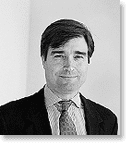
Insider asked out of home investment banker Jim Johnsen of Johnsen Fretty for an interview on what it’s like to be an out of home industry investment banker. Like any savvy dealmaker, Johnsen turned the tables and asked to interview Insider. Part 1 of the interview discusses billboard lending and interest rates.
Dave, you’ve done a terrific job building Billboard Insider into a great source of information. I enjoy reading it first thing each morning. I feel very honored to sit in your seat today. Most people in the industry know you as an editor, but some don’t know that you are also an active lender across the media industry and have built and successfully sold a media practice at least once. So tell me, how did you first get into media lending? And when did you first stumble upon the outdoor advertising business?

I entered media lending 31 years ago at Continental Illinois National Bank and Trust. I worked the Colorado desk and if you lent money in Colorado you did media because 8 of the 10 largest cable TV companies were headquartered there. I began lending to out of home advertising companies in 1997 shortly after starting a private finance company with John Weller. We wanted additional media sectors to supplement our cable TV and radio lending. After 20 years of private lending, including two recessions, we realized out of home had the best return for the least risk of all the media sectors and we shed the other sectors to focus just on out of home. We changed the name of our lending company to Billboard Loans (www.billboardloans.com) to reflect this.
After all of these years lending to the outdoor industry, if you were to sum up in 2 sentences or less what the biggest challenges to lending to the industry are, how would you do that?
The biggest challenge is educating people who want you as a senior lender to take equity risk in a project for a senior debt return. Senior lenders don’t do 100% financing for a 10% rate. The second biggest challenge is explaining to new out of home entrants that just because you can put up a digital sign doesn’t mean you should. Digital signs don’t sell themselves and are a huge investment. You need to pick locations carefully.
How will the rising interest rate environment affect out of home lending and out of home valuations?
Rising interest rates reduce debt capacity and valuations. Every 100 basis point increase in interest rates means a 4% reduction in out of home advertising debt capacity and valuations.
Higher rates reduce debt capacity because more money must go towards interest. Banks want a 7 year repayment with debt service coverage (cashflow/interest and principal payments) of 1.2 times. A small outdoor company with $300,000 of cashflow has debt capacity of $1.76 million or 4.9 times cashflow if it borrows at 5% interest (prime plus 1.25%). Debt capacity falls about 4% for every 100 basis point rise in rates. If interest rates rise from 5% to 10% debt capacity declines to $1.5 million or 4.2 times cashflow based on 7 year amortization and 1.2 times debt service coverage.
Rising rates reduce valuations because debt accounts for a large portion of each acquisition. If you purchase an outdoor company with $500,000 of cashflow at a 10 times cashflow multiple and finance half the transaction with debt at 5% you’ll receive a 15% return on equity. If the interest rate increases from 5% to 6% you’ll have to reduce your purchase price to 9.6 times cashflow to get the same 15% return on equity because your financing costs have increased. A 200 basis point rise in interest rates means the purchase price must contract to 9.2 times cashflow to get the same 15% return on equity.
[wpforms id=”9787″ title=”true” description=”true”]
Paid Advertisement

















